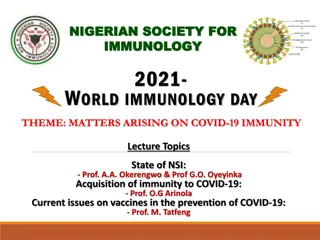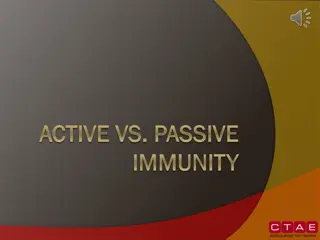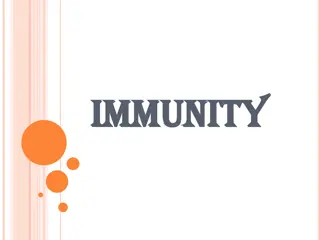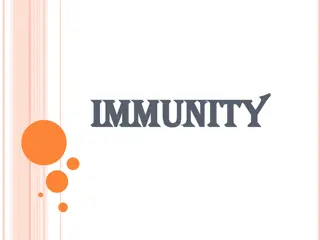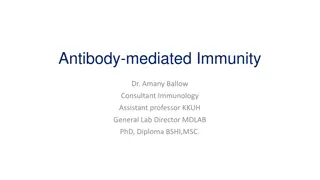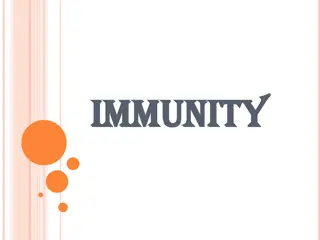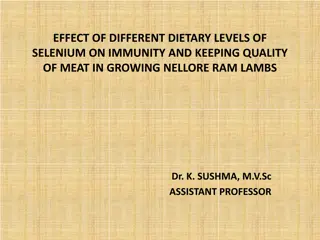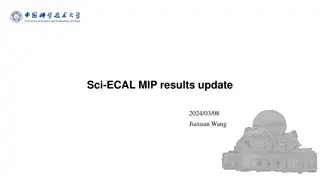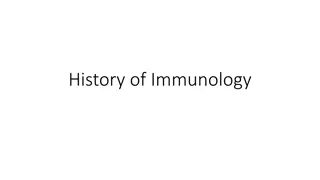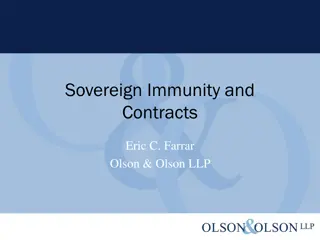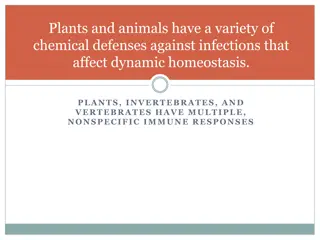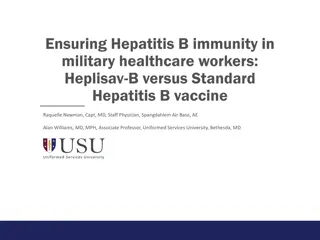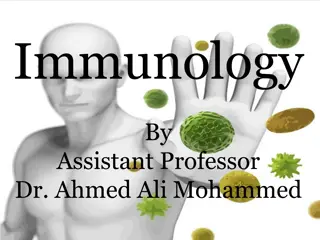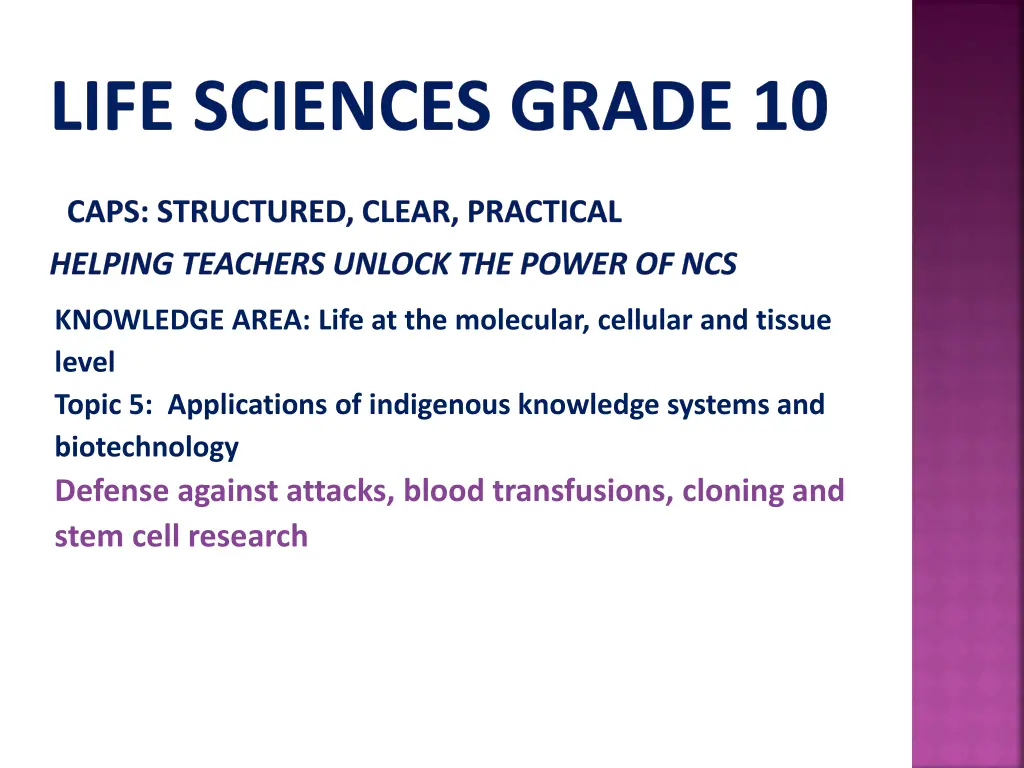
Unlocking the Power of NCS Knowledge: Life Sciences Grade 10 Applications
"Explore the defense against infections, blood transfusions, cloning, and stem cell research in Life Sciences Grade 10. Uncover the secrets of pathogen prevention and the body's lines of defense."
Download Presentation

Please find below an Image/Link to download the presentation.
The content on the website is provided AS IS for your information and personal use only. It may not be sold, licensed, or shared on other websites without obtaining consent from the author. If you encounter any issues during the download, it is possible that the publisher has removed the file from their server.
You are allowed to download the files provided on this website for personal or commercial use, subject to the condition that they are used lawfully. All files are the property of their respective owners.
The content on the website is provided AS IS for your information and personal use only. It may not be sold, licensed, or shared on other websites without obtaining consent from the author.
E N D
Presentation Transcript
LIFE SCIENCES GRADE 10 CAPS: STRUCTURED, CLEAR, PRACTICAL HELPING TEACHERS UNLOCK THE POWER OF NCS KNOWLEDGE AREA: Life at the molecular, cellular and tissue level Topic 5: Applications of indigenous knowledge systems and biotechnology Defense against attacks, blood transfusions, cloning and stem cell research
CAPS SPECIFIC AIMS 1. Knowing Life Sciences 2. Investigating Phenomena in Life Sciences 3. Appreciating and Understanding the History, Importance and Applications of Life Sciences in Society
SPECIFIC SKILLS Apply knowledge in new contexts Access information Select key ideas Use knowledge in a new way Recall information Analyse information/data Describe knowledge of NS Critically evaluate scientific information Build a conceptual framework Organise or reorganise knowledge Recognise relationships between existing knowledge and new ideas Write summaries Develop flow charts and mind maps Identify assumptions Categorise information Recognise patterns and trends
PLANT AND ANIMAL TISSUES i
SUMMARY OF PRESENTATION Defence against infections Blood transfusions Stem cell research Cloning
DEFENCE AGAINST INFECTIONS The body has two lines of defence against diseases that are caused by pathogens. The first line of defence first line of defence is to prevent the organism from entering the body in the first place. However if the pathogen is somehow able to enter the body then the second line of defence defence is engaged that is the body attempts to destroy the pathogen. second line of Do you know what is a pathogen? Do you know what is a pathogen?
SOLUTION A pathogen is a disease causing organism like bacteria, virus or fungi.
PREVENTING PATHOGENS FROM ENTERING THE BODY The pathogens that usually enter the body are very small. They are so small that they can not be seen with the naked eye. Such pathogens are called micro-organisms. These micro-organisms are also called microbes. The body tries to prevent the entry of these micro-organisms in the following way: The mucus in the nose and throat trap the microbes together with the dust particles. 1.
PREVENTING PATHOGENS FROM ENTERING THE BODY The air that enters the breathing passages is filtered by the cilia found in these passages before the air gets to the lungs, this prevents the microbes from entering the breathing system. A transparent membrane called the conjunctiva covers the eyes preventing the microbes from entering the eye. Tears also washes away any foreign particles and microbes found on the eye. 2. 3.
PREVENTING PATHOGENS FROM ENTERING THE BODY If the skin is unbroken it forms a perfect barrier preventing anything, including microbes, from entering the body. Any microbes that enters the digestive system is destroyed by the hydrochloric acid that is found in the stomach. 4. 5.
DESTROYING THE MICROBES THAT ENTER THE BODY When a pathogen enters the body, it can cause an infection. The body produces millions of white blood cells to fight the microbes that cause this infection.
DESTROYING THE MICROBES THAT ENTER THE BODY These white blood cells fight against the microbes in many ways. They are as follows: Some pathogens are swallowed up by the white blood cells. This process is called engulfment engulfment. 2. Other white blood cells either remove the poison of the microbes or they make the poison less effective. They detoxify pathogen. Then there are some white blood cells that produce antibodies antibodies that fight off the pathogens. 1. detoxify the 3.
PRODUCING ANTIBODIES The antibodies are produced to fight of infections. Antibodies are very specific, this means that each antibody is able to fight off a particular pathogen. However the are some antibodies that are able to fight off closely related microbes. For example the antibody that fights the pathogen causing cow pox can also fight off the microbe causing small pox.
WHAT IS IMMUNITY? Immunity Immunity refers to the body's ability to produce antibodies to fight against disease. There are 2 2 types of immunity. These 2 types are: Natural immunity Acquired immunity Natural immunity Natural immunity is a person s in born ability to produce antibodies and fight against disease. Acquired immunity Acquired immunity is the immunity that is obtained (acquired) by the person throughout their lifetime. 1. 2.
TYPES OF IMMUNITY - NATURAL Antibodies are specific. So if a person has antibodies against measles, these antibodies will not protect him/her against chicken pox.
TYPES OF IMMUNITY - ACQUIRED 2 types of acquired immunity. These are: Active immunity Passive immunity We shall discuss each type of immunity. There are 2 types 1. 2.
TYPES OF ACQUIRED IMMUNITY - ACTIVE Active acquired immunity occurs in the following way: A person gets a mild infection, resulting in a mild disease. b. The body produces antibodies to fight the microbe. The person is cured. d. If this disease re-enters the body then these antibodies can fight the same infection. e. Therefore this person has acquired immunity against this particular disease. a. c.
TYPES OF ACQUIRED IMMUNITY ACTIVE - VACCINATIONS Sometimes immunity can be obtained through vaccinations. This is an artificial way of acquiring immunity. Vaccinations works in the following way: A weak form of the microbe is given to the person. This maybe given by an injection or through a pill or syrup. When the pathogen enters the body the antibodies are produced against the disease. 1. 2. 3.
TYPES OF ACQUIRED IMMUNITY ACTIVE - VACCINATIONS Remember if the person is healthy he will not get the disease, but will have antibodies against it. Should a new infection occur the person already has antibodies against the disease and should not get sick. He is therefore protected against new infections. He as acquired immunity through vaccination. Vaccines have become very successful, the small pox disease is totally eradicated. Vaccines have been produced for a range of diseases. 4. 5. 6. 7.
TYPES OF ACQUIRED IMMUNITY PASSIVE IMMUNITY In passive immunity the organism does not produce its own antibodies. The antibodies are produced in one organism and then transferred to another. Therefore we say the organism is passive in the production of antibodies. This immunity does not last. One example of passive immunity is the transfer of antibodies against tetanus that is passed onto humans from horses.
ANTIBIOTICS Antibiotics are used to slow down or stop the growth of pathogens. They are given to a sick person in the form of tablets or injections or by drip (this enters the blood stream directly) or in the form of a syrup. The antibodies are made from living organisms such as bacteria or fungi. Some examples of antibiotics are penicillin and erythromycin. Penicillin is obtained from the blue green mould. Erythromycin is obtained from a bacterium.
SOMETHING FOR YOU TO DO Differentiated between acquired and natural immunity. How is immunity acquired? 1. 2.
SOLUTION: Acquired immunity is is obtained (acquired) by the person throughout their lifetime while natural immunity is a person s in born ability to produce antibodies and fight against disease. When a person gets an infection their bodies produce antibodies to fight off that infection, these antibodies remain in the body so that the next time the microbe enters the body, the person is protected against the microbe. 1. 2.
USING TRADITIONAL TECHNOLOGY TO BOOST THE IMMUNE SYSTEM There many local plants that can be used to boost the immune system. We shall discuss three of them. These are the: African potato Sutherlandia Devils claw 1. 2. 3.
USING TRADITIONAL TECHNOLOGY TO BOOST THE IMMUNE SYSTEM AFRICAN POTATO Also known as the sterretjie. It was used by the indigenous people of KwaZulu-Natal and Pondoland regions. It was used as a laxative. Scientists have recently found out that the plant is a rich source of sterols. Sterols are used to boost the immune system.
USING TRADITIONAL TECHNOLOGY TO BOOST THE IMMUNE SYSTEM AFRICAN POTATO The plant can be used to increase the body s immune system. Latest research has shown that the use of African potato has slowed down the progress of HIV/AIDS. The sterol extract has been used in the fight against tuberculosis, cancer, rheumatoid arthritis and psoriasis.
USING TRADITIONAL TECHNOLOGY TO BOOST THE IMMUNE SYSTEM SUTHERLANDIA The Sutherlandia frutescens is used for the treatment of cancer. Many other species of this plant have medicinal uses. Here are some examples: This plant was used to lower fevers and wash wounds more than 100 years ago by the Khoi San and Nama people. It was used as a treatment for chicken pox, stomach problems, internal cancers and eye-wash by the first settlers. 1. 2.
USING TRADITIONAL TECHNOLOGY TO BOOST THE IMMUNE SYSTEM SUTHERLANDIA Today the farm workers of the Western Cape use it to treat colds, influenza, asthma, TB, bronchitis, rheumatism, rheumatoid arthritis and osteo-arthritis, liver problems, hemorrhoids, bladder, uterus, diarrhea, stomach aliments, heartburn, peptic ulcers, backache, diabetes, varicose veins and inflammation. Can also be used as a tranquilizer for mental disorders, emotional stress, irritability, anxiety and depression and taken as a tonic before meals to aid digestion and improve appetite. 3. 4.
USING TRADITIONAL TECHNOLOGY TO BOOST THE IMMUNE SYSTEM SUTHERLANDIA CSIR research has shown that the Sutherlandia has the following benefits: It decreases anxiety and irritability, improves the appetite and boosts the immune system. It can result in weight gain in cancer, TB and HIV/AIDS sufferers. By boosting the immune system it seem to delay the progression of HIV into AIDS. 1. 2. 3.
USING TRADITIONAL TECHNOLOGY TO BOOST THE IMMUNE SYSTEM DEVILS CLAW Also called the hook plant. Its scientific name is harpagophytum procumens The plant is indigenous to the African continent. The tuber is the part of the plant that is used. The tuber is chopped up, dried and processed before it is used. It can be used to treat pain, fever and digestive problems.
USING TRADITIONAL TECHNOLOGY TO BOOST THE IMMUNE SYSTEM- DEVILS CLAW Now the tuber is made into a cream. The cream is used to treat: 1. Joint pain caused by osteoarthritis, gout or rheumatoid arthritis. Pain of muscle, tendons and ligaments (connective tissue). As a bitter herb it is used to calm a mild upset stomach due to indigestion, it can also be used as a digestive assistant. 2.
BLOOD TRANSFUSION During a blood transfusion the person who donates the blood is called the donor. The person who receives the blood is the recipient. During a blood transfusion the blood must not be infected and the blood type of both the recipient and the donor must match. This process is known as a cross match. If the recipient receives the incorrect blood type during a blood transfusion the blood clumps together
BLOOD TRANSFUSION The clumping slows down blood flow throughout the body. This means that blood flows at a slower rate throughout the body. This can cause death. This can be avoided by doing a cross match of the blood types of both the donor and recipient before a transfusion.
BLOOD TRANSFUSION Sometimes people know in advance that they are going to undergo a surgical procedure, they donate their own blood in advance and the hospital stores this blood, so that if during the procedure blood is required then their own blood is given to them. This avoids the incorrect blood type or contaminated blood given to them.
BLOOD TRANSFUSION The table below shows safe blood donors for various recipients. Safe blood types for Different Recipients: Blood type of recipient A B AB O Safe blood type A, O B, O A, B, AB, O O
BLOOD TRANSFUSION From the table it is evident that blood type O can be donated to persons with any blood type. Therefore blood type O is the universal donor. We also notice that AB can receive blood from persons with any blood type. Therefore blood type AB is the universal recipient.
STEM CELL RESEARCH Stem cells Stem cells are undifferentiated cells that have the ability to differentiate to form any tissue or organ in the body. Embryonic stem cells can form into any tissue or organ in the body. Therefore they can be used to replace any diseased or damaged cells or organs. For example in nerve cells are damaged then embryonic stem cells can be used to form new nerve cells.
STEM CELL RESEARCH- WHERE ARE EMBRYONIC STEM CELLS HARVESTED FROM? The technology used in stem cell research is new, but it is being used to a limited extent in the treatment of diseases such as diabetes, leukemia, Alzheimer's disease, osteoporosis and sickle cell anemia. Stem cells are harvested from frozen embryos. Where do these frozen embryos Where do these frozen embryos come from? come from? When couples cannot have children, they sometimes undergo (ivf) in-vitro fertilization. During ivf the males sperms are used to fertilize the females eggs in a petri dish in the laboratory.
STEM CELL RESEARCH- WHERE ARE EMBRYONIC STEM CELLS HARVESTED FROM? A few zygotes are produced, of these a few maybe 2 or 3 are implanted into the mothers uterus. The remainder of the embryos are frozen. The stem cells are harvested from these frozen embryos. Unfortunately once these stem cells are removed the embryos are destroyed embryos are destroyed!
STEM CELL RESEARCH- WHERE ARE EMBRYONIC STEM CELLS HARVESTED FROM? However the latest research has revealed that if one cell is removed from the embryo at the eight cell stage, the embryo will continue to develop normally with the remaining seven cells. This study was done with mice. The stem cell that was removed can be used to make new cells that maybe used to replace damaged or diseased tissue.
STEM CELLS FROM CORD BLOOD But stem cells can also be harvested from cord blood. Where does cord blood stem Where does cord blood stem cells come from? cells come from? During pregnancy the embryo is attached to the placenta by means of an umbilical cord. At birth the umbilical cord is cut, the umbilical cord at this stage contains large amounts of cord blood. Until recent times the umbilical cord together with the cord blood is thrown away.
STEM CELLS FROM CORD BLOOD It has since became known that cord blood is a very rich source of stem cells. Therefore many couples are saving the cord blood with its rich supply of stem cells for future use. The cord blood with the stem cells are stored in special cord blood banks. Therefore if in the future the child needs stem cells to treat an illness or damage to tissue or organ these stem cells maybe used. In 2005 a cord blood bank was established in Cape Town.
SHOULD STEM CELL RESEARCH CONTINUE? Stem cell research is extremely important, and is being conducted all over the world. It is hoped that the research will lead to a cure for many diseases especially neurological diseases for which there is currently no cure. However due to ethical issues in some countries the research is limited in the following ways: Only the stems cells from cord blood or from destroyed embryos maybe used.
SHOULD STEM CELL RESEARCH CONTINUE? The use of stem cells from left over embryos are banned in these countries. Ethics of stem cell research is very debatable. Those in favour of stem cell research argue that: Embryos are tiny amounts of undifferentiated tissue and Since these embryos would have been destroyed anyway it is acceptable to use them and The use of the stem cells form the eight cell embryo should be acceptable since the embryo is not affected in any way.
SHOULD STEM CELL RESEARCH CONTINUE? Those against stem cell research argue that By using human embryos we are actually using humans. It is immoral to use the embryos and to destroy them in the name of research. Others feel that even the use of the stem cells from the eight cell embryo stage is unacceptable because people should not play God.
CLONING During sexual reproduction the sperm fuses with an egg to form a zygote during fertilization. Remember that the zygote is a single cell, it must divide by mitosis to produce many identical cells to grow into a multicellular organism. Therefore with the exception of the reproductive cells all cells in the human body have the same number and kind of chromosomes. This means that they have the same genetic code.
CLONING It is the same in plants. The reproductive organ of the plant is the flower. The flower the male and female gamete fuse to form the zygote. The zygote is found within the seed. The seed germinates into a new plant. In the plant all the cells have the same number and kind of chromosome except for the gametes.
CLONING The non reproductive parts of the plant are called the vegetative parts. Examples of the vegetative parts are the roots, stems and leaves. Sometimes the vegetative parts of the plant are able to give rise to new plants. This type of reproduction is called vegetative reproduction. During this type of reproduction the cells divide by mitosis to produce more cells for growth.
CLONING Therefore all the cells are identical to each other in the new plant. Since the new plant is grown from another plant the new plant as the same genetic material as the original plant. For example if a small cutting (stem) of a rose plant is left in water it will develop roots. When it is planted in soil it will grow into a new rose plant. The new rose plant is identical to the original plant and all the cells in the new plant are identical to each other because they formed from mitosis.
CLONING If a new plant or animal is genetically identical to the original parent from which it was produced it is called a clone This process of forming a clone is called cloning cloning. Vegetative reproduction is a type of cloning. Farmers use this knowledge to produce more desirable products. For example crops that have high yields and are drought and disease resistant. Scientist have also cloned animal, using a different technique. This technique will be discussed later. clone.

